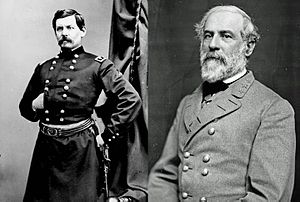
Back حملة ماريلاند Arabic Campanya de Maryland Catalan Marylandkampagnen Danish Campagne du Maryland French Campagna del Maryland Italian メリーランド方面作戦 Japanese Expeditio Terrae Mariae Latin Marylandveldtocht Dutch Campanha de Maryland Portuguese Мэрилендская кампания Russian
| Maryland campaign | |||||||
|---|---|---|---|---|---|---|---|
| Part of the American Civil War | |||||||
 Union General George B. McClellan and Confederate General Robert E. Lee, the principal commanders of the campaign | |||||||
| |||||||
| Belligerents | |||||||
|
|
| ||||||
| Commanders and leaders | |||||||
|
|
| ||||||
| Units involved | |||||||
|
|
| ||||||
| Strength | |||||||
| 102,234[1][2] | 55,000[2] | ||||||
| Casualties and losses | |||||||
|
28,272 total (2,783 killed; 12,108 wounded; 13,381 captured/missing)[3][4] |
16,229 total (3,812 killed; 10,591 wounded; 1,826 captured/missing)[5] | ||||||
The Maryland campaign (or Antietam campaign) occurred September 4–20, 1862, during the American Civil War. The campaign was Confederate General Robert E. Lee's first invasion of the North. It was repulsed by the Army of the Potomac under Maj. Gen. George B. McClellan, who moved to intercept Lee and his Army of Northern Virginia and eventually attacked it near Sharpsburg, Maryland. The resulting Battle of Antietam was the bloodiest day of battle in American history.
Following his victory in the northern Virginia campaign, Lee moved north with 55,000 men through the Shenandoah Valley starting on September 4, 1862. His objective was to resupply his army outside of the war-torn Virginia theater and to damage Northern morale in anticipation of the November elections. He undertook the risky maneuver of splitting his army so that he could continue north into Maryland while simultaneously capturing the Federal garrison and arsenal at Harpers Ferry. McClellan accidentally found a copy of Lee's orders to his subordinate commanders and planned to isolate and defeat the separated portions of Lee's army.
While Confederate Maj. Gen. Stonewall Jackson surrounded, bombarded, and captured Harpers Ferry (September 12–15), McClellan's army of 102,000 men attempted to move quickly through the South Mountain passes that separated him from Lee. The Battle of South Mountain on September 14 delayed McClellan's advance and allowed Lee sufficient time to concentrate most of his army at Sharpsburg. The Battle of Antietam (or Sharpsburg) on September 17 was the bloodiest day in American military history with over 22,000 casualties. Lee, outnumbered two to one, moved his defensive forces to parry each offensive blow, but McClellan never deployed all of the reserves of his army to capitalize on localized successes and destroy the Confederates. On September 18, Lee ordered a withdrawal across the Potomac and on September 19–20, fights by Lee's rear guard at Shepherdstown ended the campaign.
Although Antietam was a tactical draw, it meant the strategy behind Lee's Maryland campaign had failed. President Abraham Lincoln used this Union victory as the justification for announcing his Emancipation Proclamation, which effectively ended any threat of European support for the Confederacy.
- ^ V Corps (Porter): 21,000; I, II, VI, IX, XII Corps + Cav. Div.: 74,234; 3rd Div./V Corps: 7,000; Total Union strength: 102,234
Further information: Official Records, Series I, Volume XIX, Part 1, p. 67, 374 and Official Records, Series I, Volume XIX, Part 2, p. 264. - ^ a b See Maryland campaign: Opposing forces
- ^ Official Records, Series I, Volume XIX, Part 1, p. 204
- ^ Official Records, Series I, Volume XIX, Part 1, p. 549
- ^ 10,291 Confederate casualties: 1,567 killed and 8,724 wounded for the entire Maryland campaign. See: Official Records, Series I, Volume XIX, Part 1, pp. 810–13.